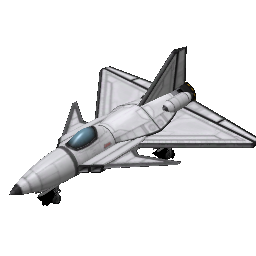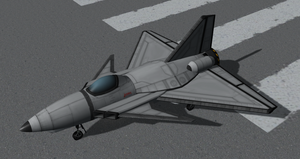Dove
The Dove is a simple SSTO capable of achieving Kerbin orbit just like the Aeris 4A. The Dove is powered by the CR-7 R.A.P.I.E.R. Engine which makes it a fully working SSTO. Although the SSTO lacks most important equipment, it's still great for training beginners on how to fly SSTOs. Its weakest point is the tiny amount of Electric Charge which cannot be replenished as its engine lacks an alternator. Fitting solar panels is recommended.


Contents
Craft Description
| “ | A Prototype Spaceplane capable of reaching Orbit. It has not yet been outfitted with any mission equipment. — Squad |
” |
Possible Improvements
The highly maneuverable and very fast Dove is fun to fly, but it has many practical limitations. As noted above, it barely has any electricity supply, only what's stored in the cockpit's batteries at launch. It has nowhere to store experiments. It can't get very far in space without a way to refuel it. Because the Dove is so small and light, all these requirements blend together a little. For instance, fittng a Z-1k Rechargeable Battery Bank between engine and body more than balances the change of inserting a Service Bay (1.25m) between cockpit and nose-cone adapter. This is because, at 2 tonnes, the engine makes up a whole 20% of the Dove's wet mass (fully filled with fuel and oxidizer) or 40% of its dry mass (empty). In turn, such a service bay is just-about large enough to contain a small docking port, piston, and some cosmetic parts. These also help balance the craft because moving the engine back that small amount is more than is needed to balance the extra nose length.
Note that the Dove may fairly be called overpowered. Air-friction heating of external parts can be a greater problem on ascent than reentry, depending of course on your reentry profile.
Balance note: The Dove's two small aft fuel tanks are prioritized to drain first. You may want to empty them when seeing how your changes affect the plane's balance. From ignition, they empty in about 80 seconds in a shallow climb at full throttle, but may last as long as 3 minutes if you climb steeply. Either way, it's a small fraction of the Dove's total flight time.
Necessity note: Equipping the Dove with a docking port and the attendant RCS is not the only way to refuel it in space. An unmodified Dove may be captured by a tug equipped with an Advanced Grabbing Unit, the tug docked with a fuelling depot, and the Dove refuelled. However, the grabbing unit - AKA The Klaw - is an aesthetically crude way to do this (although it doesn't actually do any damage), and modifying the Dove can be a fascinating challenge.
Electricity
- Fixed solar panels fitted near-flush with the surface of the wings and tail will be protected from air-friction heating while still receiving sunlight.
- Retractable solar panels have, when retracted, the same temperature tolerance of the fuselage, 2000K. However, they can't be extended in atmospheric flight. The Dove's atmospheric range, although short for a spaceplane, is still long enough that the reaction wheels could drain the cockpit's battery. You may want to disable the reaction wheels when there is enough air for the control surfaces to work. (Below 15km?) Alternatively, the force limit of the reaction wheels could be greatly reduced without hurting its space performance. (Atmospheric performance untested.)
- A Z-1k battery array holds a plentiful supply of electricity for the Dove. As noted above, it may change the balance of the craft in useful ways, depending on where it's fitted.
Docking Port
- If you have Breaking Ground, you can add a service bay containing a small docking port and piston. Make it look nice with an empty Mk0 fuel tank and some 'minimalist' flags. All this totals about 0.2 tonnes; 2/3 the weight of the Inline Clamp-o-Tron. The bay is also about half the length of the Inline Clamp-o-Tron, an important consideration when modifying the tiny Dove.
- A small docking port in a service bay without a piston. This limits docking to craft whose small docking ports stand proud of their surface.
- A small docking port fitted to the fuselage, pulled in to hide its knobbly base. It has the same temperature tolerance as the cockpit, but the effect of its drag on aeroflight range has not been evaluated. Also, its drag may cause it to heat up more than other parts.
RCS
The cockpit's reaction wheels provide plenty of power to turn the Dove. RCS is only needed for translation. The cockpit can also hold plenty of monopropellant for the lightweight Dove's needs.
Because the Dove is so light, players may want to use the lightest possible parts, but this creates a bit of a challenge with the RCS thrusters. Lightweight thrusters have a surprisingly low temperature tolerance, high-temperature thrusters are heavy. Also, the high-temperature thrusters are overpowered and would need their thrust limiters turned way down. User:eekee fitted 7 of the smallest linear RCS ports to his Dove. They were all right for a couple of missions, but on the third mission atmospheric friction destroyed four of the ports on ascent. These four ports were fitted around the center of mass, sticking out from the surface of a Mk1-Mk2 adapter. The ports which survived were fitted to the leading edge of the tail fin (pointing forward), and to the trailing points of the cones on the Mk0 fuel tanks (pointing aft). These mounting parts evidently protected the thrusters in the same way wings protect flush-fitted solar panels. The failed thrusters were moved to the leading edges of the wings where they don't even get hot.
Science
A service bay fitted as described above has room for tiny experimental sensors, or less-small ones if you don't mind them overlapping. Fitting a Z-1k battery array ahead of the engine can balance as much as 0.15t in that bay; more than the combined weight of the piston docking port and cosmetics described above.